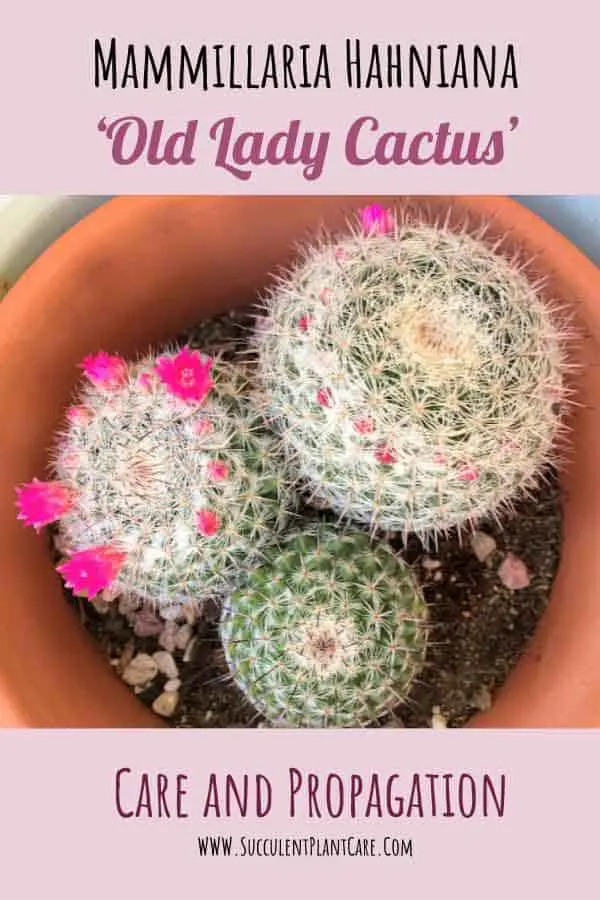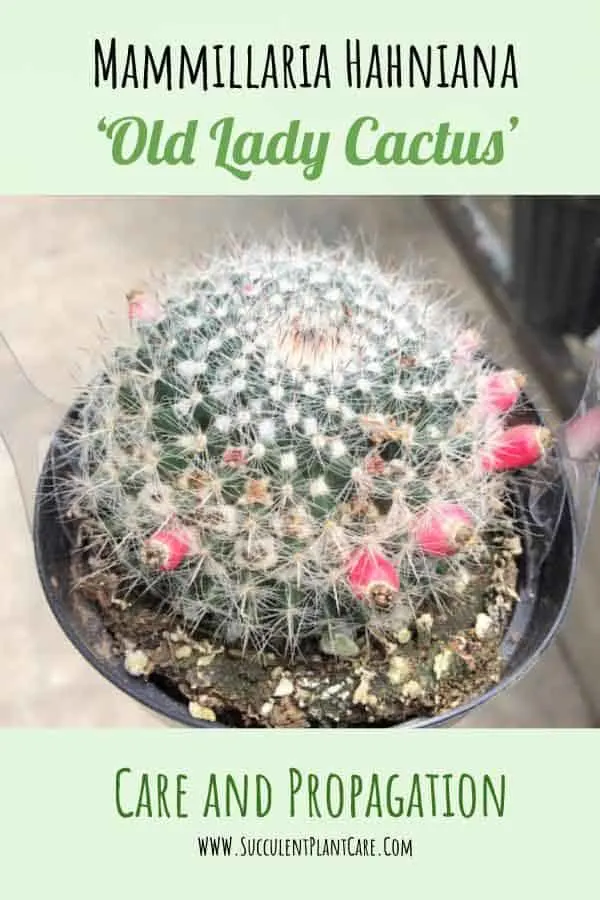Mammillaria hahniana, also known by its common name ‘Old Lady Cactus’, is a popular powder puff type cactus that is sun-loving and easy to grow. The plant, which belongs to the Cactaceae family, is particularly attractive with its lone spherical stems and flowers in hues of red-purple. It can grow up to approximately 4 in. (10cm) tall and 8in. (20cm) wide.
Due to their appearance, ease in care and flowering habits, these are one of the most popular and common cacti around. Caring for a Mammillaria hahniana ‘Old Lady Cactus’ is not a difficult task. All you need is a bit of know-how and you are set to enjoy many years with this forgiving cactus. Learn how to care for and nurture your Mammillaria hahniana ‘Old Lady Cactus’ below.

Is the Mammillaria Hahniana an Indoor or Outdoor Plant?
For the most part, the Mammillaria hahniana is known as an outdoor plant but can be grown indoors too. The Mammillaria hahniana thrives in dry, hot conditions with very little water. As such, the plant does better in an outdoor environment where it lavishes in the sun. Even though the Mammillaria hahniana loves the outdoors, it does not mean that it cannot be grown successfully indoors. The Mammillaria hahniana can grow quite well indoors in a pot if it is placed in a very sunny area and is not overwatered. If you must grow your plant indoors, provide some outdoor time during the warmer months if possible and the plant will benefit from it.
Indoor Lighting Requirements
While the Mammillaria hahniana is a slow-growing plant, it still needs sufficient light to grow and flourish. If you are growing this particular plant indoors, you will need to pay special attention to how much light it gets. Choose the brightest spot in the house to place your plant. A south-facing window is a perfect spot for a cactus of this type.
Window spots are generally sunnier than other positions in the house because they receive the most sunlight from outdoors. At the same time, window spots are also cooler than other locations in the house during the colder months because of the draft coming from outside. When choosing where to place your plant, don’t hesitate to move the plant around a few times until you find the best spot for it.
Generally speaking, Mammillaria hahniana needs approximately 4-6 hours of sunlight a day to thrive. If you can’t provide adequate sunlight indoors no matter where you place the plant, consider using a grow light. Grow lights can help supplement the lighting needs of your plant, particularly during dark, rainy days. Here are some of my grow light recommendations.
Outdoor Sunlight Requirements
The Mammillaria hahniana, which is native to Mexico, truly thrives outside in a hot and dry environment. Do not position the plant in a heavily shaded area as this is an unfavorable condition for this type of plant. Does this mean that the cactus needs to have full sun exposure all day long? No, it does not. An interesting point is that while this plant genus loves the sun, it does not do very well under very intense, direct sunlight for an excessive amount of time.
Bright, partial shade during the hottest time of the day is best for this plant. You can position your Mammillaria Hahniana in a sunny spot with afternoon shade and it should be perfectly happy. You only need to ensure that your Mammillaria hahniana gets about 4 hours of bright light per day as this will promote long-term health.
During a heatwave or intense heat, the plant may suffer from sunburn or sun damage. To prevent this from happening, move the plant to a shadier location during a heatwave. You can also provide sunshades during really hot summer days when the temperature can scorch most of your plants (over 100℉ or 38℃). Here are my sun protection recommendations.
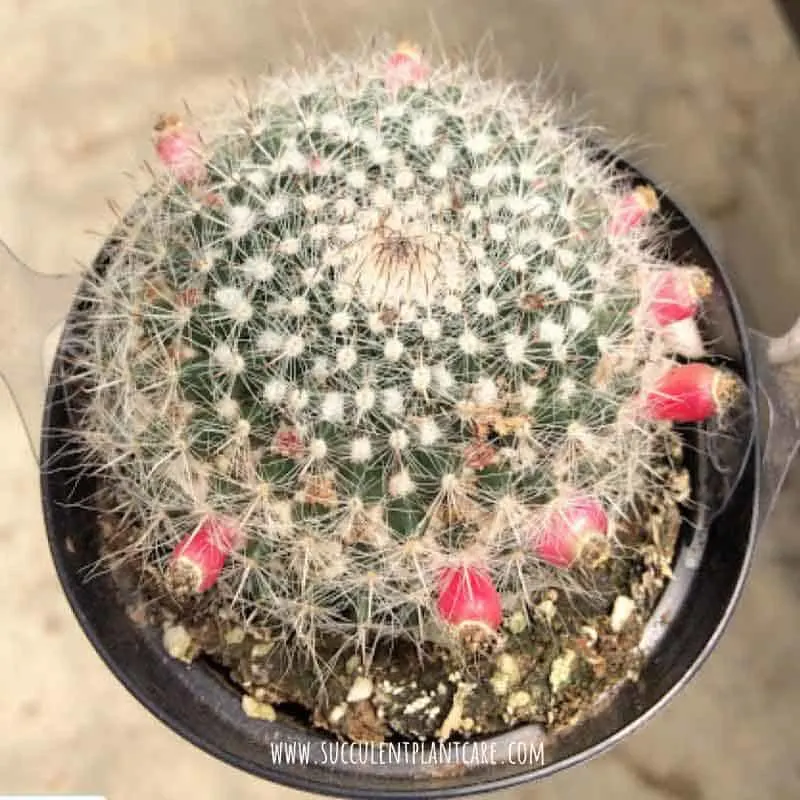
Frost Tolerance
How does a Mammillaria hahniana handle the cold weather? Is it tolerant to frost? The Mammillaria hahniana can be fairly frost resistant, especially if you keep it dry in the winter time. As a hardy plant, it is not easily upset by fluctuating weather conditions, as long as the changes are not too severe and permanent. Mammillaria hahniana owners have experienced their plant doing well in weather conditions that drop to around 23℉ or -5℃, with a bit of frost. In some cases, they have survived temperatures that drop to around 10℉ or -12℃. To ensure survival during frost, the plant needs to stay relatively dry and needs to receive adequate sunlight during the day to warm it up. If you can’t bring them indoors during the winter months, you can protect your cacti from frost by using frost cloths. Here are my frost cloth recommendations.
The plant goes dormant during the cold winter months, so don’t expect a lot of growth to happen around this time. Its true growing season is during the spring and summer months.
Soil Requirements
The Mammillaria hahniana requires well-draining, porous soil whether it is grown outdoors or indoors. What I normally do is I use a standard cactus mix combined with perlite for extra drainage. I eyeball it to about 1:1 solution of cactus mix and perlite. You can also use a sandy mixture of coarse sand and cactus mix (1:1 solution). Or you can use a combination of these three materials (1:1:1 solution of cactus mix, perlite and coarse sand) for a porous soil mixture.
To find these materials online, check out my resource page for soil recommendations.
As the plant thrives in soil with a high potassium content, think about feeding the cactus with a potassium fertilizer, at least once in summer months. To read more about this topic, click on my post “Best Soil and Fertilizer for Succulents and Cacti” for further details.
When repotting, try to do so with dry soil to make it easier to remove the plant from the pot. Leave the soil dry for a few days before watering to allow the plant to heal and recover from the shock of repotting. After a few days to about a week, water the plant thoroughly and do not water again until the soil is dry. For a step-by-step guide on how to repot a mammillaria hahniana, click on my post “Why We Need To Repot Newly Bought Succulents”.
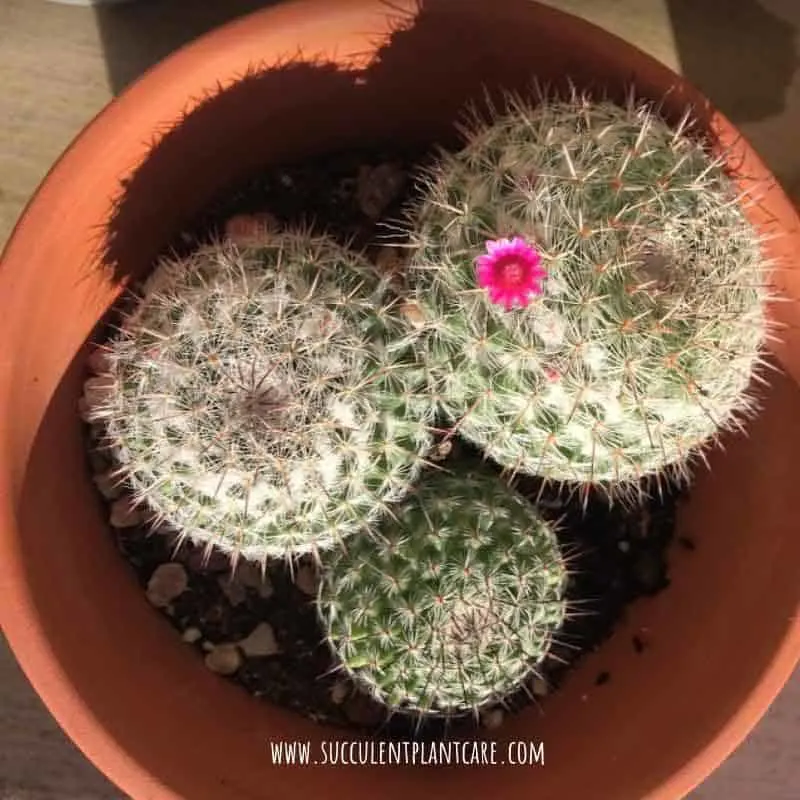
Watering Requirements
A Mammillaria hahniana that is grown outdoors requires very little maintenance and care in general. Natural rain should take care of your plant’s watering needs, but if it is not, you can water the plant once a week during summer or warmer months, and once a month during winter or cooler months. As mentioned, it is best to ease up on watering during winter. The soil should be kept quite dry during the cold winter months to encourage dormancy or a cooling period, which also encourages flowering.
A Mammillaria hahniana that is grown indoors may not need to be watered as much as outdoor plants, especially if it is not exposed to a lot of sunlight. Before watering the plant, make sure that the potting soil is dry. Water the plant thoroughly, giving it a good drink. Do not water again until the soil has completely dried out. Make sure to empty the plate of any excess water that drains out of the pot so that the plant is not sitting in water.
If you are growing the Mammillaria hahniana in a pot, it is better to choose a pot that has sufficient drainage holes to allow for excess water to flow out of the pot.
Too much water and you run the risk of root rot, which is detrimental to the plant. Avoid misting the cactus. Give it a good drink and then leave it alone until the soil is dry. The top inch of the soil needs to feel dry before you water again. If you need further help with gauging when to water your plants next, try using gadgets such as moisture meters to help detect the moisture level of the soil. Here are some of my moisture meter recommendations.
How to Propagate and Root the Mammillaria Hahniana
Offsets are your best chance of propagating the Mammillaria Hahniana, although other types of cactus plants can be effectively propagated in other ways, such as grafting, division, and cuttings. Offsets are the best option for this particular cactus because of the physiology of this plant.
You can easily propagate the Mammillaria hahniana from the offsets that develop in clusters that form around the base of a mature plant.
Follow these steps to successfully propagate your cactus:
- Gently remove the offsets from the mature plant. Wear protective gloves and use foam, cardboard, or other barriers to protect your fingers from the sharp spines.
- Place the offsets onto a piece of paper towel or in a dry location and allow them to dry out. This may take a few days depending on the humidity in your area.
- You will notice a scab-like growth forming over the cut area, which is called a callus. Optional: Once dry, dip the cut end in rooting hormone. Rooting hormone is optional and not a must but can help speed up the rooting and propagation process).
- Prepare a pot or small container with a fast-draining cactus growing medium.
- Once the offsets have dried, plant the callused edge into the soil.
- Water every week or when the soil feels dry. Place the container in a bright spot but away from direct sunlight. Allow the plant to establish itself over a few weeks before placing it in direct sunlight or planting it outside in the ground.
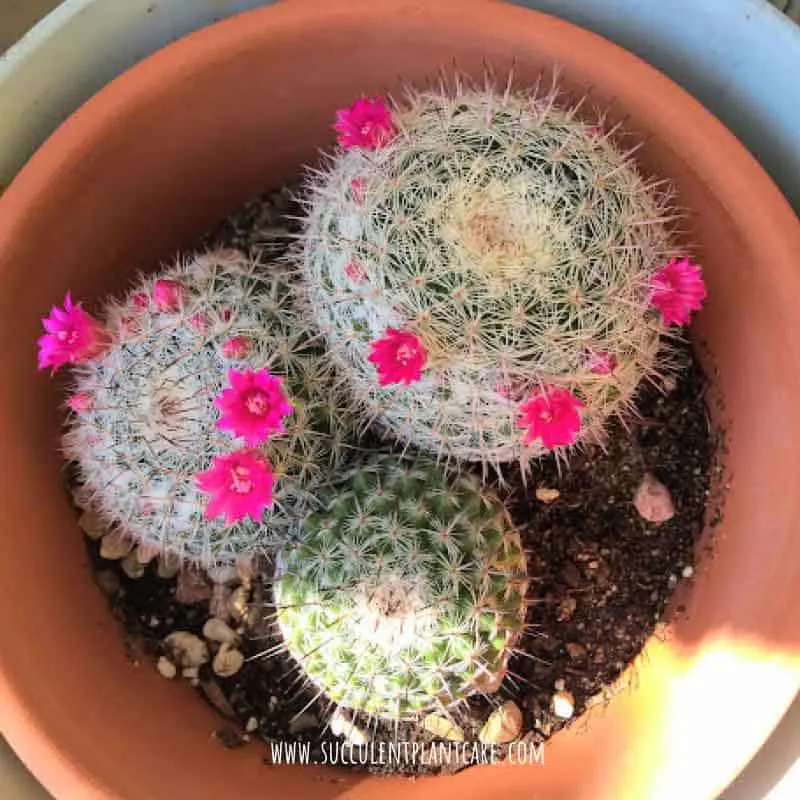
Mammillaria Hahniana Blooms
The Mammillaria hahniana usually blooms during the spring and summer months. The flowers are quite a sight to behold with their bright red-purple colors. The flowers are small and typically grow in a full circle around the outer circumference of the upper part of the plant – much like a crown or a tiara.
If your Mammillaria hahniana is not blooming as you expected, there are ways to encourage blooms. Mammillaria hahniana is one of the few cacti that blooms even when young. Keep in mind that not all cacti are ready to bloom, and some may not bloom at all. A lot depends on environmental factors beyond our control.
Encouraging better flowering requires a cooling period in winter. You should also hold back on your watering schedule in winter. Providing the Mammillaria hahniana with too much water will deter flower growth. If the plant remains damp or sits in water for too long, the plant will fail to flower completely.
After reducing water to an absolute minimum during winter and allowing the plant to be somewhat dormant, you can boost flowering in the spring and summer months. You can do this by increasing your watering steadily and feeding the plant with a fertilizer. Fertilizers are better applied at a quarter or half strength, about every two weeks during the growing season. A balanced blend of fertilizer or a fertilizer formulated for cacti and succulents diluted to half strength are both suitable. Flowering can start from late winter and go well into spring and summer. Here are some of my fertilizer recommendations.
Is the Mammillaria Hahniana Toxic or Poisonous?
When getting a new cactus, you might want to ensure that you are not getting a plant that is poisonous or toxic. The good news is that the Mammillaria hahniana has no reports of toxic effects on humans or pets. If you suspect poisoning, contact your local veterinarian immediately or the poison control center.
Mammillaria hahniana ‘Old Lady Cactus’ has become widely available due to its desirable and easy going nature. Consider these tips to help your Mammillaria hahniana flourish and grow.
Wondering where to find a Mammillaria Hahniana ‘Old Lady Cactus’? Visit my resource page for recommendations on where to purchase these and other succulents online.
Pin this to save for later or share with others now!
